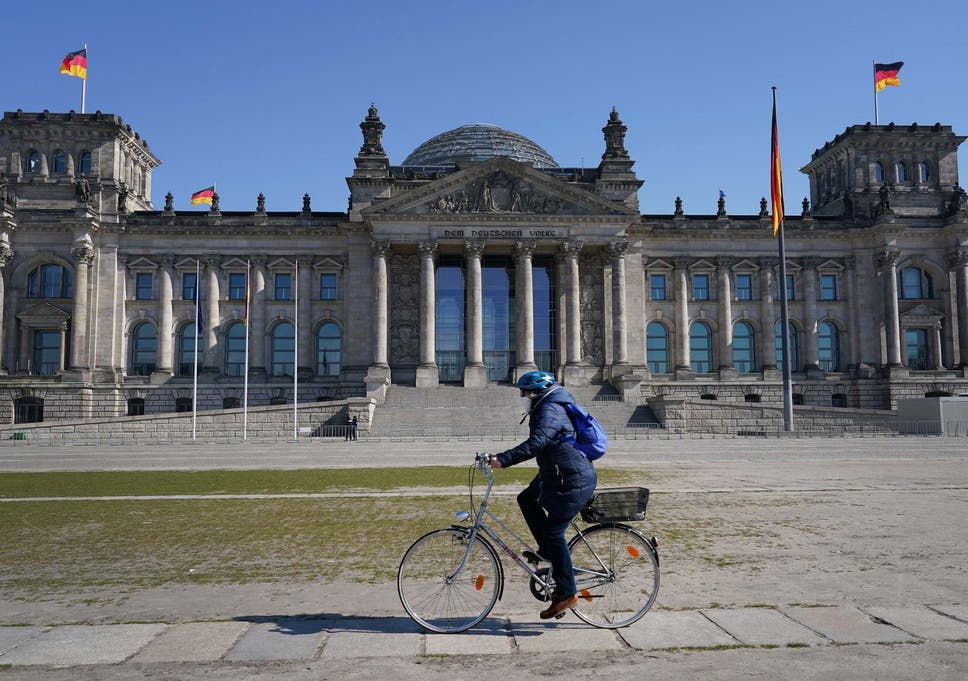
The streets of the hedonistic city of Berlin are eerily empty. As night approaches, bars and restaurants are shuttered and streets are deserted. Even the drug dealers still hanging around notorious Görlitzer Park are wearing disposable gloves.
Unlike the UK, Italy, France and Spain, Germany has stopped short of ordering a nationwide lockdown, instead opting for strict social-distancing measures, including a ban on gatherings of more than two people. Only the state of Bavaria, where the first cases were detected in January, has announced a full lockdown.
Germany has so far avoided the catastrophic levels of infection that have ravaged Spain and Italy: by Wednesday, 181 people had died from Covid-19 with 35,714 confirmed cases.
In comparison, more than 6,800 people have died in Italy, and more than 3,400 in Spain. Cases have topped 69,000 and 47,000 respectively.
Germany’s low mortality rate has puzzled experts. One theory is that it may be due to the disease spreading amongst a younger age group. According to the Robert Koch Institute (RKI), Germany’s main agency for disease control, the average age of those who have tested positive for coronavirus is 47 years old. In Italy, where the mortality rate is 9 per cent, the average age of sufferers is 63.
Experts believe that Germany’s major outbreaks stemmed from carnival celebrations and young people returning from ski trips in Italy and Austria. Elderly citizens are also less likely to live with younger members of the family than those in southern Europe.
Germany has also looked at the crisis developing in other countries and made sure its healthcare system is ready.
“We have been on high alert since January, when the first cases were detected, and we have had time to prepare,” says Professor Marilyn Addo, head of infectious diseases at University Medical Centre Hamburg-Eppendorf. She adds that Germany has learnt from other countries and has been stocking up on test kits and respirators. The high levels of preparation mean Germany has even had capacity to take in a number of critically ill Italian patients – six arrived at Leipzig airport in the eastern state of Saxony on Tuesday morning.
The country also has one of the most robust public health systems in the world, spending $5182 per capita on healthcare, compared to the UK’s $3377. There are nevertheless concerns that it may still not be able to deal with an outbreak the size of Italy’s.
“I think we have prepared as well as we possibly can, at this time,” says Addo. “In our hospital we have seven Covid patients in intensive care, and we have enough ward space for many more.”
“Everyone is holding their breath right now and seeing what happens next,” she concludes, adding that if admissions jump to 20 a day or more at her hospital, then they may “start to struggle”.
Experts have also suggested that Germany’s high levels of testing mean milder cases that go undetected elsewhere are showing up in data. The German doctors’ association estimates that more than 200,000 coronavirus tests have been run in the past weeks. In contrast, only 64,000 people had been tested in Britain by 18 March. “RKI recommended broad testing very early in order to detect cases as soon as possible and slow the spread,” says spokesperson Marieke Degen. “This is probably why we started to see cases very early, as well as mild ones which in other circumstances might have been missed.”
According to the National Association of Statutory Health Insurance Physicians, Germany has capacity for about 12,000 Covid-19 tests each day. However, Addo says that gaining access to the tests is still a problem in many places and could worsen if infection rates jump up. “We need more mobile testing units,” she explains, adding that people have been flooding emergency rooms.
Christian Drosten, a virologist at Berlin’s Charité hospital who advises the German health ministry, told Die Zeit newspaper that the mortality rate is likely to rise if testing cannot keep up with demand and the disease spreads amongst the elderly population. “It will appear that the virus has become more dangerous, but this will be a statistical artefact, a distortion,” he explained.
On the ground in Berlin, residents say they are currently having trouble accessing testing even after coming into contact with known infections. Johannes Koch, who lives in the district of Neukölln, told The Independent he is still waiting to hear back from the Berlin authorities after attending a party linked to a Covid-19 case two weeks ago.
A call-out was released asking anyone who had visited Kater Blau nightclub between 4am and 9pm on 7 March to get in touch after a reveller tested positive for the disease. “I was only there for one hour until 5am but I thought I should still contact them,” says Koch, who says he sent multiple emails with no response. “Every time I tried to call the line was busy.”
Koch eventually tested negative for the disease after visiting a clinic outside Berlin, but says the friends he attended the party with still haven’t had a response.
Medical professionals caution that it is too early to say how infection and mortality rates may shift in the coming weeks. “It is very important to remember that, in Germany, we are at the very beginning of the epidemic,” says Degen. “We are seeing more and more deaths and we don’t know how everything will develop.
UPDATE (26.03.20) A previous version of this article's headline stated that Germany had become Europe’s first country to "flatten the curve" in relation to Covid-19 mortality rates. We would like to make clear that at the time of publication, there had been no conclusive finding that Germany had in fact "flattened the curve"; the headline has been amended to reflect this.







